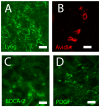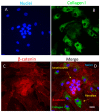Cellular and Molecular Processes in Wound Healing
- PMID: 37760967
- PMCID: PMC10525842
- DOI: 10.3390/biomedicines11092526
Cellular and Molecular Processes in Wound Healing
Abstract
This review summarizes the recent knowledge of the cellular and molecular processes that occur during wound healing. However, these biological mechanisms have yet to be defined in detail; this is demonstrated by the fact that alterations of events to pathological states, such as keloids, consisting of the excessive formation of scars, have consequences yet to be defined in detail. Attention is also dedicated to new therapies proposed for these kinds of pathologies. Awareness of these scientific problems is important for experts of various disciplines who are confronted with these kinds of presentations daily.
Keywords: acute wounds; cellular infiltrate; chronic wounds; keloids; scars.
Conflict of interest statement
The authors declare no conflict of interest.
Figures




Similar articles
-
Toward understanding scarless skin wound healing and pathological scarring.F1000Res. 2019 Jun 5;8:F1000 Faculty Rev-787. doi: 10.12688/f1000research.18293.1. eCollection 2019. F1000Res. 2019. PMID: 31231509 Free PMC article. Review.
-
Human In Vitro Skin Models for Wound Healing and Wound Healing Disorders.Biomedicines. 2023 Mar 30;11(4):1056. doi: 10.3390/biomedicines11041056. Biomedicines. 2023. PMID: 37189674 Free PMC article. Review.
-
Dermal Fibroblast Heterogeneity and Its Contribution to the Skin Repair and Regeneration.Adv Wound Care (New Rochelle). 2022 Feb;11(2):87-107. doi: 10.1089/wound.2020.1287. Epub 2021 Mar 23. Adv Wound Care (New Rochelle). 2022. PMID: 33607934 Review.
-
Epithelial-mesenchymal transition in the formation of hypertrophic scars and keloids.J Cell Physiol. 2019 Dec;234(12):21662-21669. doi: 10.1002/jcp.28830. Epub 2019 May 20. J Cell Physiol. 2019. PMID: 31106425 Review.
-
The Role of Chemokines in Fibrotic Wound Healing.Adv Wound Care (New Rochelle). 2015 Nov 1;4(11):673-686. doi: 10.1089/wound.2014.0550. Adv Wound Care (New Rochelle). 2015. PMID: 26543681 Free PMC article. Review.
Cited by
-
A Systematic Review of Human Amnion Enhanced Cartilage Regeneration in Full-Thickness Cartilage Defects.Biomimetics (Basel). 2024 Jun 25;9(7):383. doi: 10.3390/biomimetics9070383. Biomimetics (Basel). 2024. PMID: 39056824 Free PMC article. Review.
-
Electrospun Nanofiber Scaffolds Loaded with Metal-Based Nanoparticles for Wound Healing.Polymers (Basel). 2023 Dec 20;16(1):24. doi: 10.3390/polym16010024. Polymers (Basel). 2023. PMID: 38201687 Free PMC article. Review.
-
Inflammation-Modulating Biomedical Interventions for Diabetic Wound Healing: An Overview of Preclinical and Clinical Studies.ACS Omega. 2024 Nov 1;9(45):44860-44875. doi: 10.1021/acsomega.4c02251. eCollection 2024 Nov 12. ACS Omega. 2024. PMID: 39554458 Free PMC article. Review.
-
Hydrogen-Releasing Micromaterial Dressings: Promoting Wound Healing by Modulating Extracellular Matrix Accumulation Through Wnt/β-Catenin and TGF-β/Smad Pathways.Pharmaceutics. 2025 Feb 20;17(3):279. doi: 10.3390/pharmaceutics17030279. Pharmaceutics. 2025. PMID: 40142944 Free PMC article.
-
Microvascular, Biochemical, and Clinical Impact of Hyperbaric Oxygen Therapy in Recalcitrant Diabetic Foot Ulcers.Cells. 2025 Aug 4;14(15):1196. doi: 10.3390/cells14151196. Cells. 2025. PMID: 40801628 Free PMC article.
References
-
- Gupta S., Andersen C., Black J., Fife C., Lantis J.I., Niezgoda J., Snyder R., Sumpio B., Tettelbach W., Treadwell T., et al. Management of Chronic Wounds: Diagnosis, Preparation, Treatment, and Follow-up. Wounds Compend. Clin. Res. Pract. 2017;29:S19–S36. - PubMed
Publication types
LinkOut - more resources
Full Text Sources

